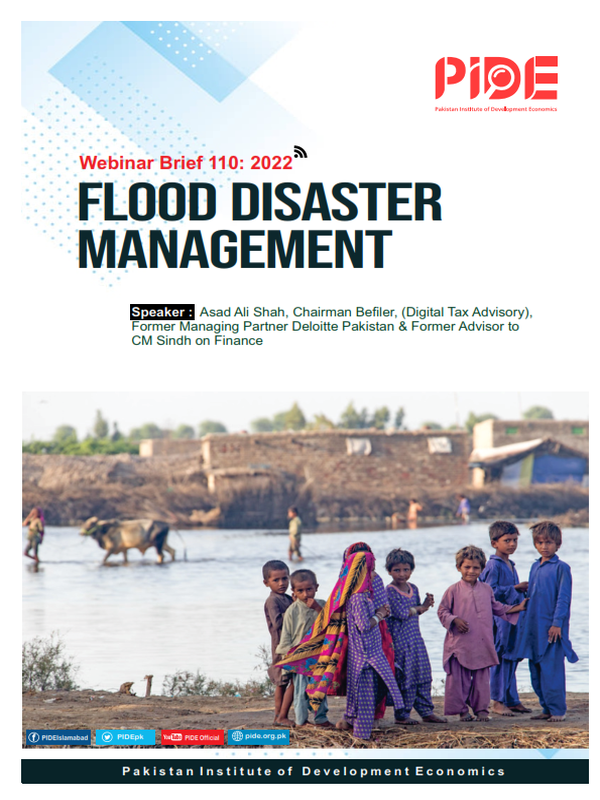Flood Disaster Management
Speaker : Asad Ali Shah, Chairman Befiler, (Digital Tax Advisory), Former Managing Partner Deloitte Pakistan & Former Advisor to CM Sindh on Finance
Pakistan was ravaged by unprecedented flooding during this monsoon season leaving behind at least 2000 dead, 33 million displaced, three million homes destroyed or damaged, and a third of the country underwater for weeks. An initial estimate shows damages to the north of US$ 32 billion. With better disaster management, i.e., mitigation, preparedness, and timely response, losses of lives and property could have been significantly lower as the warnings about heavy rainfalls were issued by the metrological department weeks in advance.
Climate Change and temperature rise are considered the main reasons for many of the disasters, including the current flooding in Pakistan. Climate change is widely believed to be caused by the emission of green gases (CO2). Pakistan contributes less than 0.6% of CO2 but is one of the most affected countries. Advanced economies, mostly western, which have been the biggest polluters for centuries, have only recently started efforts to address the issue, notably with the Paris accord, to mitigate the climate effects and create a global responsibility for the earth’s future. The global response to the devasting floods in Pakistan has been a challenge, with commitments of only US$ 600 million and, so far, provision of barely 15% of the committed amount.
State of the Disaster Management System in Pakistan
- The National Disaster Management act of 2010
The National Disaster Management act of 2020 provides a legal framework by defining disaster and its management, including preparedness, response, recovery and rehabilitation, and reconstruction. The act constitutes the National Disaster Management Commission (NDMC) headed by the Prime Minister and leader of the opposition, chief ministers, federal ministers, the President of AJK, the Chairman of CJCS, and the Secretary of NDMA.
- National Disaster Management Commissionis responsible for making policies for disaster management, approving the national plan, devising guidelines to be followed by provincial authorities, arranging and provision of funds for mitigating measures, preparedness, and response, providing support to other countries, and taking measures of prevention or mitigation or preparedness, and capacity building for disaster management.
- National Disaster Management Authority: is the executive arm of the National Disaster Management Commission responsible for overseeing a whole spectrum of disaster management activities on the federal level.
Major Challenges of Disaster Management System in Pakistan:
- National Disaster Management Commission does not have the most appropriate combination; it is mainly comprised of politicians and bureaucrats, i.e., the Prime Minister, Ministers, and a secretary with no real experts in the field.
- The commission is very centralized, with all decision-making needing the approval of the Prime Minister.
- Lack of capacity for disaster planning and mitigation plan in the public sector, even private organizations in the corporate sector have the far better and more valuable experience and fairly better disaster management plans but are not utilized by the government.
Reasons for Huge Devastation and Delays in Returning to Normalcy
- In addition to faulty and unorganized development blocking waterways, overall poor Disaster Management Strategies including:
- Inadequate drainage
- Unavailability of the hydrological engineer or experts who understand the water flows
- Unavailability of contingency planning for dewatering.
- Poor on-spot decision-making owing to poor capacities of on-field officers and lack of delegation of authority to lower-level on-field personnel. Officers from the field have to seek approval from the higher authorities through long and slow bureaucratic channels.
- Lack of cooperation and overlapping responsibilities among various departments leads to conflict and chaos, for instance, DC and local government, public health, and irrigation.
- Unpreparedness and very slow response from the NDMA and PDMAs.
- Poor governance and a culture of no accountability for the outcomes, even in the cases of criminal negligence.
Future Exposures:
- Pakistan, with the largest glaciers outside the polar region, haphazard development, and poor governance, has huge exposure to future disasters. Sindh and other parts of the country, like Northern Areas and AJK, are at huge risk and to the level of existential crises from various fronts, including:
- Melting of glaciers
- Rains
- Sea Rising/ Intrusion
- Combination of all
The Way Forward:
- A national dialogue is needed on critical issues of how to prevent such disasters.
- Unless fundamental issues of governance are addressed, we should expect more and even bigger disasters.
- Serious need to overhaul our disaster management system.
- We need to modify our approach to development and plan better and improve the drainage system.




